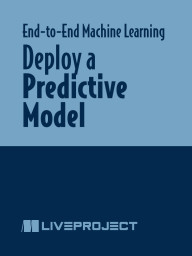projects by Harshit Tyagi
End-to-End Machine Learning for Rain Prediction
In this multi-part liveProject series, you’ll harness the power of machine learning to make predictions about future rainfall. The Weather Department of Australia is having trouble handling meteorological data manually, and your challenge is to build an end-to-end machine learning model that can make on-the-fly predictions. You’ll use common Python data tools to clean and classify your dataset for analysis, train and evaluate your model, and then deploy your model to a remote server using Flask and Heroku. Work from beginning to end, or dive into whichever section will best augment your skills.
Deploy a Predictive Model
In this liveProject, you’ll deploy a machine learning model to production so it can be easily used by colleagues. You’ll create a virtual environment for deploying your application, use Flask to build a local web service that returns predictions, and Heroku for remote deployment.
Evaluate a Binary Classifier
Judging the effectiveness of a machine learning model requires in-depth analysis. This quick liveProject builds on the work you have completed in Machine Learning for Classification. You’ll assess your early models and consider better alternatives. You’ll plot the ROC curves of the model and compare it to multiple dummy models, and tune your hyperparameters to deliver the most accurate results possible.
Train a Binary Classifier
In this liveProject, you’ll explore a pre-made dataset of meteorological records. You’ll learn the shape, size and type of data at hand, and discover factors that affect rainfall. You use scikit-learn and logistics regression to make initial predictions about future rainfall, evaluate their accuracy, and visualize emerging patterns using Seaborn and Matplotlib.
Predicting Disease Outbreaks with Time Series Analysis
Time series analysis is an essential tool for data forecasting, allowing data analysts to make predictions about the future events and track relationships between data. In this liveProject, you’ll utilize the Python data ecosystem and time series analysis to analyze the spread of the COVID-19 virus in different parts of the globe.
Your goal is to make near-future predictions about virus spread based on your available data. You’ll start with an exploratory data analysis into the types of data you have access to, establishing the kind of questions it can reasonably answer. You’ll then develop an ARIMA model for time-series forecasting. Finally, you’ll develop an interactive Voilà dashboard using ipywidgets that will allow stakeholders to access and understand your analysis.




